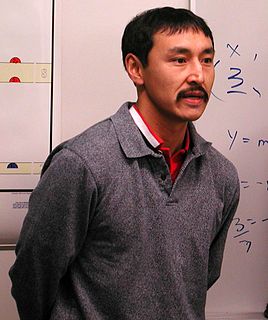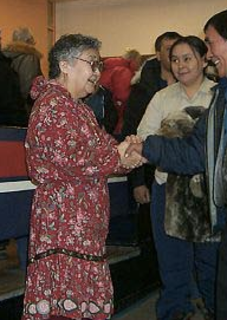Devolution is the statutory delegation of powers from the central government of a sovereign state to govern at a subnational level, such as a regional or local level. It is a form of administrative decentralization. Devolved territories have the power to make legislation relevant to the area.

Paul Okalik is a Canadian politician. He is the first Inuk member to have been called to the Nunavut Bar and the first Premier of Nunavut.

The Minister of Crown–Indigenous Relations is one of two Cabinet ministers that administer Crown-Indigenous Relations and Northern Affairs Canada (CIRNAC), which is responsible for administering the Indian Act and other legislation dealing with "Indians and lands reserved for the Indians" under subsection 91(24) of the Constitution Act, 1867. The minister is also more broadly responsible for overall relations between the federal government and First Nations, Métis, and Inuit. The position was created alongside the Minister of Indigenous Services when Prime Minister Justin Trudeau announced on August 28, 2017 that the federal government intended to abolish the Indigenous and Northern Affairs Canada department.

Nunatsiavut is an autonomous area claimed by the Inuit in Newfoundland and Labrador, Canada. The settlement area includes territory in Labrador extending to the Quebec border. In 2002, the Labrador Inuit Association submitted a proposal for limited autonomy to the government of Newfoundland and Labrador. The constitution was ratified on 1 December 2005, at which time the Labrador Inuit Association ceased to exist, and the new Government of Nunatsiavut was established, initially being responsible for health, education and cultural affairs. It is also responsible for setting and conducting elections, the first of which was executed in October 2006. An election for the Ordinary Members of the Nunatsiavut Assembly was held on 4 May 2010. The Nunatsiavut Assembly was dissolved on 6 April in preparation for the election. Its incumbent president is Johannes Lampe who assumed office in 2016.

Kitikmeot Region is an administrative region of Nunavut, Canada. It consists of the southern and eastern parts of Victoria Island with the adjacent part of the mainland as far as the Boothia Peninsula, together with King William Island and the southern portion of Prince of Wales Island. The regional seat is Cambridge Bay.

Helen Mamayaok Maksagak, was a Canadian politician. She served as the Commissioner of the Northwest Territories (Canada) from January 16, 1995 until March 26, 1999 and as the Commissioner of Nunavut from April 1, 1999 until April 1, 2000. She is a notable Copper Inuk.

The history of Northwest Territories capital cities begins with the purchase of the Territories by Canada from the Hudson's Bay Company in 1869, and includes a varied and often difficult evolution. Northwest Territories is unique amongst the other provinces and territories of Canada in that it has had seven capital cities in its history. The territory has changed the seat of government for numerous reasons, including civil conflict, development of infrastructure, and a history of significant revisions to its territorial boundaries.
The Northwest Territories division plebiscite was a stand-alone territory wide plebiscite conducted on April 14, 1982. This was the first territory wide plebiscite conducted in Northwest Territories history. The results of the plebiscite would eventually lead to the creation of Nunavut, and spawn three other plebiscites during the creation process of the new territory.
The Tunngavik Federation of Nunavut was the organization officially recognized from 1982 to 1993 as representing the Inuit of what is now Nunavut, but was then part of the Northwest Territories, for the purpose of negotiating treaties and land claims settlements. In this role, it replaced the Inuit Tapiriit Kanatami, which represents Inuit across Canada, and has been superseded by Nunavut Tunngavik Incorporated.
Nunavut Tunngavik Incorporated is the legal representative of the Inuit of Nunavut for the purposes of native treaty rights and treaty negotiation. The presidents of NTI, Makivik Corporation, Nunatsiavut, and the Inuvialuit Regional Corporation, the four regional land claims organizations, govern the national body, the Inuit Tapiriit Kanatami (ITK) as its board of directors. NTI continues to play a central role in Nunavut, even after the creation of the Government of Nunavut. As the successor of the Tunngavik Federation of Nunavut, which was a signatory of the Nunavut Land Claims Agreement on behalf of Inuit, NTI is responsible for ensuring that the Nunavut Land Claims Agreement is implemented fully by the Government of Canada and the Government of Nunavut and that all parties fulfill their obligations.
Tagak Curley is an Inuit leader, politician and businessman from Nunavut. As a prominent figure in the negotiations that led to the creation of Nunavut, Tagak is considered a living father of confederation in Canada. He was born in a hunting camp at Coral Harbour, Northwest Territories.

The history of Canada (1992–present) refers to the period immediately following the end of the Cold War, until present.
The History of the Northwest Territories begins with the population of the region by First Nations peoples, and proceeds through the transformation of it into provinces and territories of the nation of Canada, including the modern administrative unit of the Northwest Territories. When Europeans settlers began to divide the continent, the Northwest Territories included much of the sparsely populated regions of what is now western Canada. Over time, the provinces of Alberta, Saskatchewan, and Manitoba were formed out of the territories. In 1898, the Yukon territory became a separate entity and in 1999 Nunavut was formed from the eastern section.
The region now known as Nunavut has supported a continuous population for approximately 4000 years. Most historians also identify the coast of Baffin Island with the Helluland described in Norse sagas, so it is possible that the inhabitants of the region had occasional contact with Norse sailors.

Canada welcomed its most recent territory, Nunavut, on April 1, 1999 after it separated from the Northwest Territories. With Nunavut's separation from the Northwest Territories came a need for new regulations regarding cultural history. Nunavut has the unique experience of having a large Aboriginal community that creates strong cultural ties within the legislation.
A plebiscite on the boundary between Northwest Territories and the new territory of Nunavut was held in the Northwest Territories on 4 May 1992. The proposed border was approved by 54% of voters. A second referendum later in the year gave the final approval to the creation of the new territory.
Indigenous or Aboriginal self-government refers to proposals to give governments representing the Indigenous peoples in Canada greater powers of government. These proposals range from giving Aboriginal governments powers similar to that of local governments in Canada to demands that Indigenous governments be recognized as sovereign, and capable of "nation-to-nation" negotiations as legal equals to the Crown, as well as many other variations.









